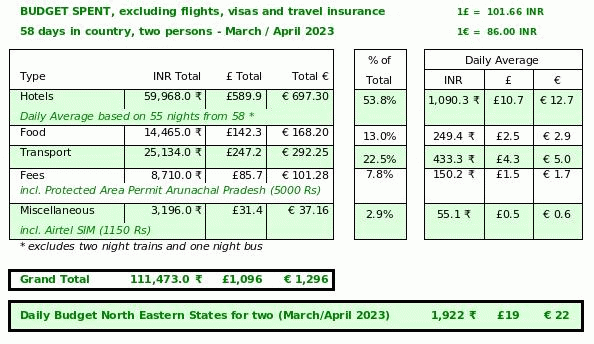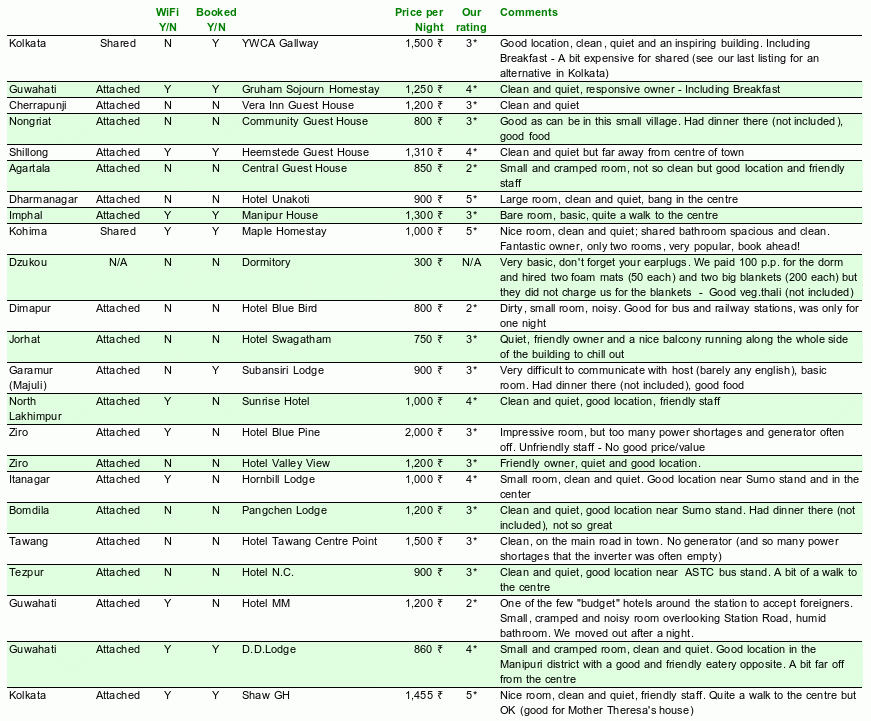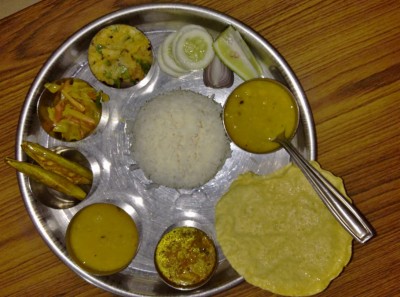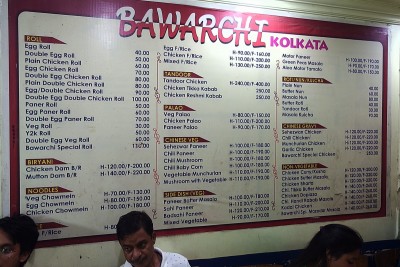Trip Report and Budget
(vero;2023-July-14)
Planning our SevenUp23 trip has been difficult. The usual travel guides are quite superficial, dedicating too few pages to such a big region and are in part outdated (although Lonely Planet claims his last edition completely updated and revised 2022: for mainland India maybe, but surely not for the north east). The difficulty comes also from the fact that this region is hardly visited by foreign tourists (and if so, most do it with a guide and private car). We were starting the trip after two years of Covid crisis and this meant there were not many blogs from Westerners, the most recents dated 2019, and the others we found were from Indian bloggers who tend to travel in groups or with a private car. The planning phase was all in all a very time consuming and sometimes frustrating affair but we managed well in the end; We had a good idea of what we wanted to see and were resolved to investigate all the unknown, particularly the transport connections, once on the ground. There were some positive news though: all states except Arunachal Pradesh are now permit free for foreigners, this made travelling easier, a good thing since securing the PAPs (Protected Area Permits) for Arunachal Pradesh was not so straight forward as we thought.
 We landed in Kolkata and after a night in the city boarded a night train to Guwahati (Assam), the gateway to the region. After a few days to get acclimatised we headed to Meghalaya, followed by Tripura, Manipur, Nagaland, Assam and Arunachal Pradesh, finishing in Guwahati before boarding a second night train back to Kolkata where we spent a few days before flying back home. You can retrace our route on this map showing our itinerary.
We landed in Kolkata and after a night in the city boarded a night train to Guwahati (Assam), the gateway to the region. After a few days to get acclimatised we headed to Meghalaya, followed by Tripura, Manipur, Nagaland, Assam and Arunachal Pradesh, finishing in Guwahati before boarding a second night train back to Kolkata where we spent a few days before flying back home. You can retrace our route on this map showing our itinerary.
We were there for 58 days and managed on a budget of 1922 Rs (€22/£19) per day for the two of us. More than half of it was for accommodation (53.8%), then came local transport (22.5%), food (13%), fees (7.8%) and other assorted stuff (2.9%). This is much more than what we spent during our last trip in 2018: our daily average back then was 1173 Rs for the two of us, an increase of 64%, mainly due to a rise of inflation, a significant increase in the price of accommodation (nearly double to what we paid in 2018) and a lot of ground covered by public transport.
- Hotels: the thing with "For Indians Only" accommodation and advance payments, summary of our hotels with prices and comments
- Food: hurrah for the unlimited thalis!
- Transport: train, local buses, Wingers, Sumos and a few ferries. See also our separate page for a detailed report with prices and comments.
- Fees: include the PAPs (Protected Area Permits) for Arunachal Pradesh, not so easy to secure…
- Miscellaneous: includes the cost of an Indian Airtel SIM
Hotels
During this trip, we dropped our bags in 23 different rooms; we used Booking.com to book eight of them (Kolkata 2x, Guwahati 2x, Shillong, Imphal, Kohima and Majuli), we found the rest on the ground and the only town where we had really a hard time finding something "cheap" without booking ahead was when we returned to Guwahati. Our accommodation budget turned out to be quite expensive compared to what we were used to in the past: we paid an average of 566 Rs in 2018, this year it was 1034 Rs. This may have to do with the region in itself: it is not difficult to find cheap hotels in touristy states like Rajasthan, Kerala or Goa, but in the north east they are very scarce. And if cheaper, they often do not accept foreigners who are often too demanding and involve too much paperwork and contact with the police: not worth the effort.
Be aware that many hosts on Booking.com request an advance payment via bank transfer, which is not possible for us foreigners: make sure to contact your hotel of choice upfront or after the booking to make sure this is not an issue for them. We never had any problem but it is a matter of trust between you and your host.
Our most expensive room was at the YWCA in Kolkata with 1500 Rs shared, the cheapest was in Agartala with 850 Rs attached. See a summary below:

As usual, our diet is very simple… mostly vegetable thalis in the evening, snacks, biscuits or crackers during the day, the occasional Indian sweet before going to bed, purified water and if fizzy drink, local brand only. No alcohol.  We have breakfast in our room, preparing our own tea and boiling water with a heating coil, munching some biscuits or crackers with it. Pricewise, a vegetable thali will typically cost anything between 70 and 120 Rs (except in Kohima where prices started at 250 Rs although we were lucky to find Ali and his Rice Hotel who charged 100 Rs and where we had our dinner every day). We were pleasantly surprised to find that all thalis in the north east come with refill, a big difference to what we had experienced during our last Indian trip in 2018 when thalis were served as one plate only… When in Kolkata, we grew very fond of the famous Kathi Rolls, typical street food of the city. Prepared with all kinds of fillings, they became our standard evening food.
We have breakfast in our room, preparing our own tea and boiling water with a heating coil, munching some biscuits or crackers with it. Pricewise, a vegetable thali will typically cost anything between 70 and 120 Rs (except in Kohima where prices started at 250 Rs although we were lucky to find Ali and his Rice Hotel who charged 100 Rs and where we had our dinner every day). We were pleasantly surprised to find that all thalis in the north east come with refill, a big difference to what we had experienced during our last Indian trip in 2018 when thalis were served as one plate only… When in Kolkata, we grew very fond of the famous Kathi Rolls, typical street food of the city. Prepared with all kinds of fillings, they became our standard evening food.
Transport (see our separate page for a detailed report with prices and comments)
After everything Vero had read about transport in the north east while planning the trip, it turned out to be not so bad as dreaded although it was a defining feature of this trip. The issue is that distances are huge and travel takes a lot of time on roads which are not always up to the job (to say the least). We used public transport throughout and this involved a mix of night and day trains, an overnight bus, local buses, Wingers (mini-buses) and Sumos (sort of a land-rover taking 11+ passengers).
When possible, we tried to use trains as much as possible, which worked perfectly within the state of Tripura, but the choice was limited for the rest of our itinerary. Most memorable were our overnight bus journey from Shillong to Agartala, the awful state of the roads in Manipur, the many roadworks in Assam as well as the tiring and long Sumo journeys in Arunachal Pradesh. Transport has been so important during this trip that we have a separate page dealing with it.
Fees
They make up 7.8% of our total budget and the bulk of it is for the fee paid to obtain our PAPs (Protected Area Permit) for Arunachal Pradesh: 2500 Rs per person. It was not an easy process…
- PAPs (Protected Area Permits) for Arunachal Pradesh: another headache for Vero while planning the trip. Researching the official website of the Arunachal Pradesh government was of no use as they had contradictory information on different pages and could not be trusted; infos found on blogs were all vague and diverging (unless they used a travel agency to obtain it), except for this very detailed report by Lost with Purpose who had easily obtained a permit in person in Guwahati. Check however before heading there and read the comments at the end of the article, we have heard that the office is now closed. We decided to follow in her steps and arrived well prepared in Guwahati, making our way to the office of the Deputy Resident Commissioner Office of Arunachal Pradesh on our very first day in town. Alas, it didn't turn out as expected… We were welcomed by a friendly man named Manab who let us in his office and started to process our application: we filled in the required papers, all was going as described in the blog, although we grew a bit doubtful when the man wanted to see our Covid vaccination certificates and our ETAs (Electronic Travel Authorisations issued as proof of our e-Visa and to be shown on arrival to obtain the visa stamp in our passports). Both were not needed: we had our visa stamp and proof of vaccination was not required anymore. When it came to paying, the man suddenly wanted to see 50$ per person, although we were expecting 30$. We grew suspicious and uncomfortable but he told us about a new process via New Delhi to obtain the authorisations, what did we know… The best came when we asked for an invoice and a receipt for our application: he gave us a hand-written acknowlegment on ordinary paper with his signature but without any stamp. That's when we knew for sure that we were on the brink of being scammed: a government agency issuing a receipt without official paper or stamps in India, the realm of bureaucracy? NO WAY! We gathered our papers and money and turned away as fast as we could. We were so disguted that we were considering abandoning our plans to explore Arunachal Pradesh, but decided to give it another try. Vero had contacted several travel agencies from home to gather information and one of them, Kaziranga Holidays, had replied and offered to arrange our PAPs at no extra cost than the 30$ per person required. We called Mr Rajkumar Das, the manager, and after he confirmed his offer, we made an appointment with him for the following day. He was incredibly friendly and helpful, driven by the desire to help us. Which he did splendidly: although we had a bit of doubt when we handed him the money, we trusted him and were right to do so. We were relieved to receive our PAPs via WhatsApp two to three weeks later, it took longer than expected but all was well in the end. If you are considering booking some trip to Arunachal Pradesh, Kaziranga National Park or other destinations in the north east, we highly recommend Mr Das and his Kaziranga Holidays.
- Natural Reserves: for foreigners, the entry fee for Nongriat (Meghalaya) was 50 Rs per person. The foreigner fee for Dzükou Valley (Nagaland) was 200 Rs per person plus a camera fee of 200 Rs per camera (they did not charge for phones).
- Other fees: the north east operates dual pricing, where foreigners pay more than Indian nationals (sometimes significant more). Nevertheless, we found most entry fees for museums or palaces quite reasonable, ranging from 50 Rs to 300 Rs per person, the Victoria Memorial in Kolkata being the most expensive at 500 Rs per person (foreigner). A good surprise were the sculpted rocks of Unakoti (Tripura) which were free of charge: incredible for such an amazing site. The only time we decided against visiting a site was in Sibsagar (Assam) where a fee of 300 Rs per person (foreigner) was requested for each monument in the area (there were at least four of them which we might have visited otherwise): we found this a rip-off and simply looked from the outside (and did not have the feeling of missing much).
Miscellaneous
- Indian Airtel SIM: one requirement for the PAPs was to be contactable and give a telephone number to the authorities. For foreign tourists travelling with a private car or an agency, this contact would be the telephone number of their driver or guide. Since we were travelling independently we decided to get an Indian number and the first thing we did in Kolkata on our day of arrival was to purchase a SIM card. After some research we had selected Airtel as our operator of choice and we did not regret it: contrary to reports in many (pre-Covid) blogs, connectivity in the north east is quite good, the only place where we did not have a signal being Dzükou Valley, which is understandable as it is in the middle of nowhere. Getting the SIM turned out to be easy, but it was a bit of an adventure though. Someone on Trip Advisor had recommended the Airtel Store on the south side of Park Street near the eponymous metro station, so that's where we went. We were greeted by a salesperson who escorted us outside and brought us to a guy sitting on a bench under a parasol with a folding table in front of him. On the table were phones and many SIMs. He asked for Thomas' passport and entered his details in a phone, took our own phone and inserted a SIM, did some magic and after a few attempts it eventually worked. He was dealing with two other "customers" at the same time while setting us up, going from one phone to the other. I was quite nervous having passport and phone laying on this table, free for anybody to grab if they wanted to, and always kept a hand on them when he did not need them. Would not have been necessary, but it was nevertheless a weird experience. We started with a one month package (850 Rs incl. the card) which we had to renew 30 days later in Imphal (300 Rs), an easy and incredibly quick procedure: we did not have to find an Airtel store, many one-man shops/stalls in the street were offering that service. We simply gave our number and the guy typed some stuff on his phone and we were already done. It was our first time with a phone on a long-distance trip and I must say I quite enjoyed it: it made it easier to contact hotels, find and exchange infos on the road, WiFi was not a criteria for selecting a hotel which broadened the choice and it was very handy to keep in contact with our family elders.
- Others: we had a spell of bad weather with rain on and off for two weeks so that we ended up purchasing two brollies in Dharmanagar for 150 Rs each. And last not least, we visited Kolkata's Decathlon on Shakespeare Sarani at the end of our trip to replace our three years old sturdy daypack which had got very grimy and had quite suffered after two months of rough treatment with a new one of the same model (1299 Rs hardly cheaper than back home).
Want to read more? Go back to Introduction or go on to Some Planning Links or go up to Blog
$ updated from: Blog.htxt Mon 28 Apr 2025 14:55:27 trvl2 — Copyright © 2025 Vero and Thomas Lauer unless otherwise stated | All rights reserved $




